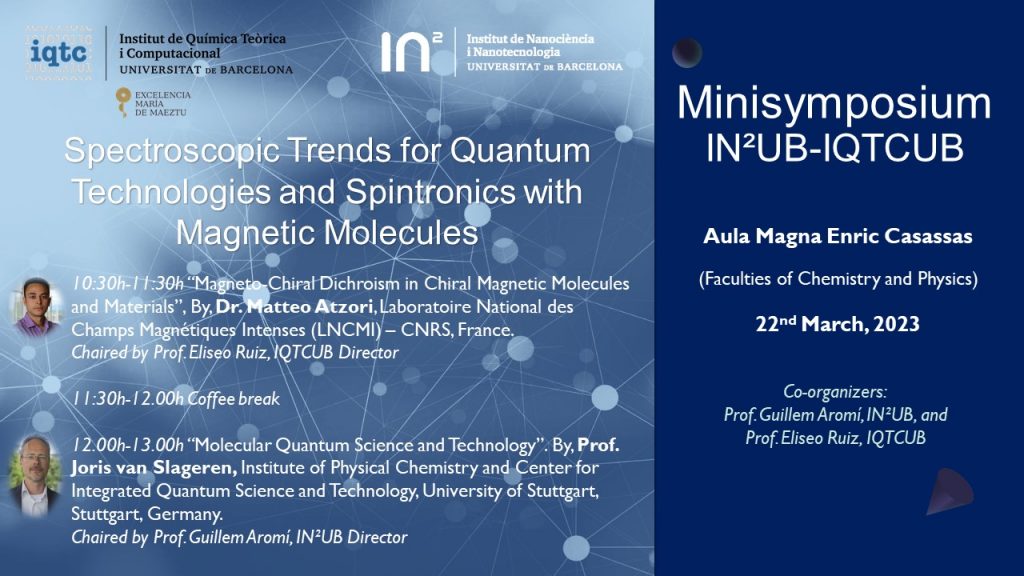Minisymposium IN²UB-IQTCUB:
Spectroscopic Trends for Quantum Technologies and Spintronics with Magnetic Molecules
Aula Magna Enric Casassas (Faculties of Chemistry and Physics)
22nd March, 2023
This event will be also streamed, click HERE to join
PROGRAM
10:30h-11:30h “Magneto-Chiral Dichroism in Chiral Magnetic Molecules and Materials”, By, Dr. Matteo Atzori, Laboratoire National des Champs Magnétiques Intenses (LNCMI) – CNRS, France. Chaired by Prof. Eliseo Ruiz, IQTCUB Director
Magneto-Chiral Dichroism (MChD) is a fascinating but scarcely investigated manifestation of light-matter interaction specific of chiral magnetized systems. It features an unbalanced absorption or emission of unpolarized light that depends on the relative orientation of the applied magnetic field and the light wavevector and the absolute configuration of the system. Its relevance is related to potential technological applications, such as the optical read-out of magnetic data, and its possible implication as a mechanism for the emergence of life homochirality. With this talk I will provide an overview of the most recent results we have achieved on this topic, that are aimed at understanding the microscopic parameters and the physico-chemical ingredients that are key to observe strong MChD responses.
11:30h-12.00h Coffee break
12.00h-13.00h “Molecular Quantum Science and Technology”. By, Prof. Joris van Slageren, Institute of Physical Chemistry and Center for Integrated Quantum Science and Technology, University of Stuttgart, Stuttgart, Germany. Chaired by Prof. Guillem Aromí, IN²UB Director
Molecular quantum architectures may spearhead the second quantum technology wave, due to favourable tunability and positionability of molecular qubit materials. We report on successful strategies to increase the quantum coherence time of such species. We also describe the immbolization of molecular quantum bits as self-assembled monolayers on surfaces, which is a critical step torwards device application. Finally, we demonstrate microwave pulse storage in strongly coupled cavity-spin ensemble systems, exploiting the large spin density of molecular qubits.
SPEAKERS
Matteo Atzori is a CNRS researcher at the Laboratoire National des Champs Magnétiques Intenses (LNCMI – CNRS, Grenoble – France). During the PhD (University of Cagliari, Italy – University of Angers, France), he worked on chiral functional molecular materials showing magnetism and electrical conductivity. Then he worked on the quantum coherence properties of vanadium complexes at the University of Florence (Italy). Currently, he is investigating Magneto-Chiral Dichroism in chiral molecules and materials. Matteo won several awards, including the silver medal of the European Young Chemists’ Award 2018 of EuChemS, and has co-authored more than 40 publications and a book, Functional Molecular Materials.
Joris van Slageren (1973) studied chemistry at the University of Utrecht. He obtained his PhD degree (2000) from the University of Amsterdam (Netherlands) on a thesis dealing with the photochemistry and photophysics of transition metal compounds. He then switched fields to Molecular Nanomagnetism, which has been his main field of study ever since. He was a post-doc with Profs. Gatteschi and Sessoli in Florence, Italy (2000 – 2002). Subsequently, he became Molecular Magnetism group leader at the First Institute of Physics at the University of Stuttgart (Germany) culminating in the award of a Habilitation degree (2007). He then took up his first permanent position as Lecturer in Inorganic Chemistry at the University of Nottingham (UK). Just three years later, he was offered a position as Professor in Physical Chemistry at the University of Stuttgart, where he currently still is.
Co-organizers:
Prof. Guillem Aromí, IN²UB, and Prof. Eliseo Ruiz, IQTCUB
Right of information in relation to the data processing: Assistants’ Right Information
With the collaboration of PhD program on Nanoscience UB

